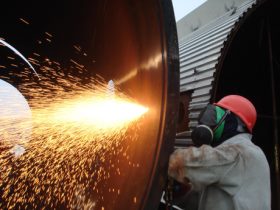Sellafield Ltd is putting in place a new kind of long-term commercial mechanism to secure specialist decommissioning services over a ten-year period. The work could be worth up to £1.5 billion ($2.6 billion).
 |
| Sellafield seeks suppliers to help with decommissioning (Image: Sellafield Ltd) |
The Decommissioning Delivery Partnership (DDP) is not a traditional contract but a commercial framework agreement giving Sellafield Ltd access to specialist goods and services when needed to support its own workforce. There is no guaranteed work or committed expenditure, but according to Sellafield Ltd's announcement, "the rewards to chosen suppliers could be great."
The new model will replace the existing system of four-year decommissioning framework agreements, which the company says does not permit adequate long-term continuity for complex programs. Furthermore, the longer nature of the arrangement is expected to provide better security of demand for the supply chain, which Sellafield expects to drive innovation and investment in people, technology and infrastructure for the companies involved.
The work to be covered by the DDP has been split into three lots centred on Sellafield's four legacy pond and silo facilities. The first portion covers the Pile Fuel Storage Pond and the Pile Fuel Cladding Silo, as well as site remediation and decommissioning projects and other areas including waste and effluent disposition. The second lot covers the First Generation Magnox Storage Pond, while the third encompasses the Magnox Swarf Storage Silo. Lot 1 will see multiple contracts awarded while the remaining lots will comprise single partnering organisations with a lead partner.
Sellafield's legacy ponds and silos were built to prepare fuel for reprocessing or storage and date back to the earliest days of the UK's nuclear program: the Pile Fuel Cladding Silo, commissioned in 1952, was the first intermediate level waste storage facility commissioned at the site. Radioactive materials including sludges have accumulated in the facilities since operations ended, and the facilities themselves - now over 50 years old - were not designed with decommissioning in mind and so present many challenges.
In late June, a joint venture of Balfour Beatty and Cavendish Nuclear were awarded a £160 million ($272 million) third-phase contract to construct a new mechanical handling plant, the Silo Maintenance Facility at Sellafield, to support the Magnox Swarf Storage Silos and Pile Fuel Cladding Silo. Earlier this year a joint venture of Areva, Atkins and Mace was selected to supply a facility to encapsulate wastes recovered from the Magnox Swarf Storage Silo in a contract worth up to £1.2 billion ($2.0 billion), while a £240 million ($402 million) facility to handle radioactive sludge from the First Generation Magnox Storage Pond is in the final stages of commissioning.
Sellafield Ltd has formally launched the acquisition process for the DDP and begun pre-qualifying for interested contractors, with a view to a tendering process at the end of 2014 and the announcement of the preferred suppliers in mid-2015. The current four-year decommissioning framework agreement was awarded in 2011 to four partners drawn from nuclear and other specialist engineering and service companies will be due to expire in 2015.
Researched and written
by World Nuclear News




_18570.jpg)
_18938.jpg)
_33584.jpg)
_82983.jpg)





